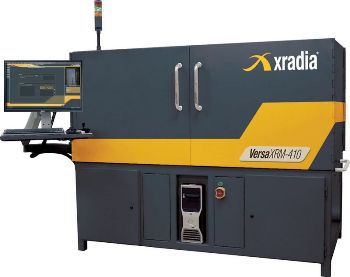Xradia, Inc. is announcing the expansion of its lab-based VersaXRM family to bridge the gap between high-performing 3D X-ray microscopy (XRM) solutions and traditionally lower-cost, less capable projection-based computed tomography (CT) systems.
 Xradia's New VersaXRM-410 for Science
Xradia's New VersaXRM-410 for Science
The VersaXRM-410 delivers the advantages of the VersaXRM family including highest resolution and contrast and in situ capabilities that enable ground-breaking research for the widest range of sample sizes. [See related announcement, "Xradia Highlights Groundbreaking Research Enabled by VersaXRM 3D X-ray Microscopes"].
The University of California, Irvine, is using the VersaXRM-410 to nondestructively characterize the microstructure and mechanics of composite materials with applications in civil, mechanical, aerospace and biomedical engineering. Professor Lizhi Sun says, "The newly installed VersaXRM-410 lets us characterize the behavior and local deformation of materials in 3D in their native environments (in situ) while uniquely maintaining sub-micron resolution across an array of sample dimensions and environments. What's even more powerful is that we can extend the understanding of a material's microstructure to the 4th dimension (3D + time) by studying how a microstructure evolves over time, and quantify that change. Only non-destructive X-ray tomography lets us achieve that goal."
Dr. Kevin Fahey, Chief Materials Scientist and VP of Marketing at Xradia, says the VersaXRM family was architected to make advanced imaging capabilities available to more researchers worldwide. "Research facilities face economic constraints, but at the same time, studies increasingly demand the non-destructive, high-resolution, high-contrast 3D imaging enabled by XRM," Fahey says. "VersaXRM brings synchrotron-like capabilities to the lab, overcoming the resolution and contrast limitations of traditional micro-computed tomography approaches to advance studies being conducted today and into the future."
VersaXRM: Extending the Boundaries of Science
The VersaXRM family with its unique architecture offers the only imaging solution that combines:
- Non-destructive 3D X-ray imaging, preserving and extending the use of valuable samples
- High resolution: 0.9 µm true spatial resolution on the VersaXRM-410 with minimum achievable voxel size of 100 nm*
- Advanced contrast: absorption contrast and unique phase contrast enable unparalleled imaging quality for soft materials such as unstained tissue or low-Z materials like carbon fibers and polymers, with the ability to differentiate between phases of similar density
- Industry-leading 4D and in situ capabilities including for flexible sample sizes and types, enabled by the VersaXRM's Resolution at a Distance (RaaD™)
Leveraging Xradia's pre-eminent position as a provider of X-ray microscopes to the synchrotron community, the introduction of the award-winning VersaXRM-500 in 2011 extended the boundaries of lab-based imaging. Since then, VersaXRM family instruments have advanced groundbreaking research in numerous fields such as in materials science, life sciences, oil and gas exploration, mineralogy, and the electronics industry.
The VersaXRM-410: Bridging the Cost-Resolution Gap
The VersaXRM-410 microscope represents a powerful "workhorse" solution that is ideally suited to diverse lab environments. The instrument delivers the high resolution associated with VersaXRM at costs more typical of lower resolution micro- or nano-CT solutions.
Standard on the VersaXRM-410 is Xradia's Scout-and-Scan™ Control System, providing easy set-up and control of experiments for a wide range of users with varying skillsets typical of a busy scientific imaging lab. The system also features Wide Field Mode (WFM) offering up to a 90 mm 3D field of view, double the capability of older systems. A new enhanced workstation provides higher performance while keeping the system in cost/performance ranges accessible to a large spectrum of users and research institutions. Additionally, a new optional 150kV 30W high power source enables up to 3X faster imaging for the largest fields of view.
*About Resolution
Voxel (sometimes referred to as "nominal resolution" or "detail detectability") is a geometric term that contributes to but does not equal resolution. Xradia specifies on spatial resolution, the most meaningful measurement of an instrument's performance.